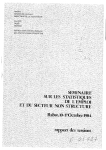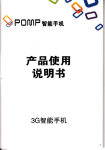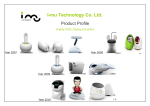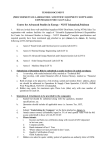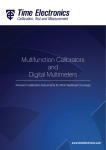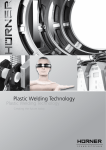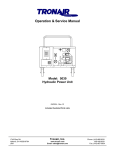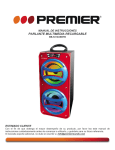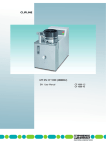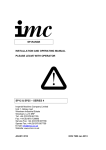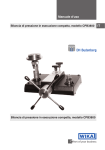Download T1500 User Manual (a) - Terwin Instruments Ltd
Transcript
TERWIN INSTRUMENTS LIMITED USER MANUAL T1500 COMPARISON TEST PUMP BEFORE USING THE T1500, PLEASE READ THIS MANUAL. T:\Terwin Templates\Manuals\T1500\T1500 User Manual (a).docx Page 1 of 33 T:\Terwin Templates\Manuals\T1500\T1500 User Manual (a).docx Page 2 of 33 CONTENTS 1 GENERAL INFORMATION ............................................................................................................ 5 1.1 2 EXPLANATION OF SYMBOLS ............................................................................................... 5 SAFETY .......................................................................................................................................... 6 2.1 INTENDED USE....................................................................................................................... 6 2.2 SKILLED PERSONNEL............................................................................................................. 7 2.3 PERSONAL PROTECTIVE EQUIPMENT (P.P.E.) .................................................................... 7 2.3.1 SPECIAL HAZARDS ........................................................................................................ 7 2.4 HANDLING ............................................................................................................................ 7 2.5 HAZARDS .............................................................................................................................. 8 2.5.1 2.6 MINERAL OIL HEALTH & SAFETY INFORMATION ........................................................ 8 LABELLING & SAFETY MARKS .............................................................................................. 9 2.6.1 PRODUCT LABEL & IDENTIFICATION ........................................................................... 9 2.6.2 EXPLANATION OF OTHER MARKINGS & SYMBOLS.................................................... 9 3 COMPANY CONTACT INFORMATION .................................................................................... 10 4 MODEL T1500 SPECIFCATION .................................................................................................. 11 4.1 GENERAL SPECIFICATIONS ............................................................................................... 11 4.2 TECHNICAL DRAWINGS .................................................................................................... 12 4.2.1 FRONT VIEW ................................................................................................................ 12 4.2.2 SIDE VIEW .................................................................................................................... 12 4.2.3 TOP VIEW ..................................................................................................................... 13 4.2.4 TEST POINT CONNECTIONS........................................................................................ 14 4.3 5 4.3.1 OILS SUITABLE FOR THE T1500 .................................................................................... 15 4.3.2 OTHER LIQUIDS ............................................................................................................ 15 DESIGN & FUNCTION ................................................................................................................ 16 5.1 DESCRIPTION ...................................................................................................................... 16 5.2 PACKING LIST ..................................................................................................................... 16 5.3 T1500 BASE UNIT ................................................................................................................. 16 5.4 SPINDLE & BASE UNIT ......................................................................................................... 17 5.4.1 SECTIONED VIEW OF SPINDLE PUMP ........................................................................ 17 5.4.2 SPINDLE PUMP............................................................................................................. 17 5.4.3 RESERVOIR................................................................................................................... 18 5.4.4 CONTROL VALVES ...................................................................................................... 18 5.4.5 CONNECTION BLOCKS .............................................................................................. 18 5.5 6 LIQUIDS USED...................................................................................................................... 15 FUNCTION ........................................................................................................................... 19 TRANSPORT PACKAGING & STORAGE ................................................................................... 20 T:\Terwin Templates\Manuals\T1500\T1500 User Manual (a).docx Page 3 of 33 7 6.1 TRANSPORTION .................................................................................................................. 20 6.2 PACKAGING ...................................................................................................................... 20 6.3 STORAGE ............................................................................................................................ 20 COMMISIONING & OPERATION .............................................................................................. 21 7.1 UNPACKING ....................................................................................................................... 21 7.2 ENVIRONMENTAL REQUIREMENTS ................................................................................... 21 7.3 ASSEMBLY ........................................................................................................................... 21 7.3.1 FASTENING T1500 BASE TO BENCH ........................................................................... 21 7.3.2 CONNECTION OF TEST ITEM & THE REFERENCE MEASURING INSTRUMENT .......... 22 7.3.3 FILLING THE BASE UNIT WITH LIQUID.......................................................................... 22 7.3.4 REMOVING (BLEEDING) AIR FROM THE BASE UNIT ................................................. 22 7.3.5 POST ASSEMBLY TESTS ................................................................................................ 23 7.4 TESTING PROCEDURE ........................................................................................................ 23 7.4.1 TEST POINT CONNECTIONS........................................................................................ 23 7.4.2 APPLYING PRESSURE .................................................................................................. 23 7.4.2.1 APPLYING PRESSURE 0 – 140 BAR (2,030 PSI) ....................................................... 23 7.4.2.2 APPLYING PRESSURE ABOVE 140 BAR (2,030 PSI) ............................................... 23 7.4.2.3 DURING CALIBRATION ........................................................................................... 24 7.4.2.4 COMPLETION .......................................................................................................... 24 8 MAINTENANCE & CLEANING .................................................................................................. 25 8.1 PERIODIC MAINTENANCE ................................................................................................. 25 8.2 CORRECTIVE MAINTENANCE ........................................................................................... 26 8.2.1 REMOVING THE COVER............................................................................................. 27 8.2.2 RESERVOIR SEALS........................................................................................................ 27 8.2.3 VALVE SEALS ............................................................................................................... 27 8.2.4 SPINDLE PUMP............................................................................................................. 27 8.2.5 HUB ASSEMBLY ............................................................................................................ 28 8.3 CLEANING .......................................................................................................................... 28 8.3.1 9 OIL OPERATION .......................................................................................................... 28 FAULTS ........................................................................................................................................ 29 10 ACCESORIES .............................................................................................................................. 31 11 END OF LIFE & DISPOSAL .......................................................................................................... 32 T:\Terwin Templates\Manuals\T1500\T1500 User Manual (a).docx Page 4 of 33 1 GENERAL INFORMATION The model T1500 comparison test pump described in this user manual has been designed and manufactured using state-of-the-art technology. All components are subject to stringent quality control during production. This user manual contains important information on handling and commissioning your T1500. Anyone operating it must have carefully read and understood this user manual prior to beginning any work. Working safely requires that safety, and work instructions are observed at all times during operation. Please observe your relevant local general safety, and accident prevention regulations for the T1500’s range of use. This user manual is part of the product and must be kept in the immediate vicinity of the instrument and be readily accessible to any user involved in the instruments use and operation. Terwin Instruments liability is void in the case of any damage caused by using the product contrary to its intended use, non-compliance with these operating instructions, assignment of insufficiently qualified skilled personnel or unauthorised modifications to the instrument. Terwin Instruments reserve the right to change the contents or form of this user manual at any time without prior notice having been given. 1.1 EXPLANATION OF SYMBOLS WARNING! – Indicates a potentially dangerous situation that can result in serious injury or death, if not avoided. CAUTION! – Indicates a potentially dangerous situation that can result in light injuries or damage to equipment or the environment, if not avoided. INFORMATION! – Points out useful tips, recommendations and information for efficient and trouble-free operation. T:\Terwin Templates\Manuals\T1500\T1500 User Manual (a).docx Page 5 of 33 2 SAFETY WARNING! – Before installation, commissioning and operation, ensure that the pressure ranges you wish to test are suitable for the specification and range (1200 bar or 17,4000 psi) of the T1500 comparison test pump. Non-compliance could result in death or serious injury and/or damage to the T 1 5 0 0 . INFORMATION! – Further important safety instructions can be found in the individual chapters of these operating instructions. 2.1 INTENDED USE Test pumps serve as pressure generators for the testing, adjustment and calibration of mechanical and electronic pressure measuring instruments through comparative measurements. These pressure tests can take place in the laboratory or workshop, or on site at a suitable measuring point. The T1500 comparison test pump features two connections, one for the test item and the second for the reference measuring instrument. The test points can be used in any order. If you connect the test item and a sufficiently accurate reference measuring instrument to the test pump, on actuating the pump, the same pressure will act on both instruments. By comparison of the two measured values at any given pressure value, a check of the accuracy and/or adjustment of the pressure measuring instrument under test can be carried out. The integrated dual-area spindle pump enables rapid filling of the test system and smooth pressure generation up to 1,200 bar or 17,400 psi. At the same time, the precise, adjustable spindle pump also enables fine pressure adjustment. A control schematic for pressure generation on the instrument base facilitates quick and easy operation. The pump is further characterised by the spindle which runs solely within the pump body. This eliminates any harmful bending moment from an externally running spindle and, especially for field operation, there is the advantage that dimensions of this pump do not alter during operation through the rotation of the spindle INFORMATION! – The term “reference measuring instrument” in these operating instructions refers to any pressure measuring instrument, such as: pressure gauge, electrical pressure measuring instrument and pressure transmitter with electrical output. The comparison test pump system is only as accurate as the reference measuring instrument used. The reference measuring instrument should be regularly calibrated in order to ensure that its accuracy is maintained. The instrument has been designed and built solely for the intended use described here, and should only be used accordingly. The technical specifications contained in these operating instructions must be observed. Improper handling or operation of the instrument outside of its technical specifications requires the instrument to be taken out of service immediately and inspected by Terwin Instruments Service Department. T:\Terwin Templates\Manuals\T1500\T1500 User Manual (a).docx Page 6 of 33 2.2 SKILLED PERSONNEL Skilled personnel are understood to be personnel who, based on their technical training, knowledge of measurement and control technology and on their experience and knowledge of country-specific regulations, current standards and directives, are capable of carrying out the work described and independently recognising potential hazards associated with the instrument. 2.3 PERSONAL PROTECTIVE EQUIPMENT (P.P.E.) Personal protective equipment is designed to protect the skilled personnel from hazards that could impair their safety or health during the operation of the instrument. When carrying out the various tasks on and with the instrument, the skilled personnel must wear the correct personal protective equipment. FOLLOW THE INSTRUCTIONS DISPLAYED IN YOUR WORK AREA REGARDING PERSONAL PROTECTIVE EQUIPMENT! WEAR SAFETY GOGGLES! – Always protect your eyes from flying particles and liquid splashes. 2.3.1 SPECIAL HAZARDS WARNING! – Improper handling can result in considerable injury and damage to p e op l e a nd equipment. The activities described in these operating instructions should only be carried out by skilled personnel who have the qualifications described in Section 2.2 Unqualified personnel should not operate the T1500. 2.4 HANDLING Handle mechanical precision measuring instruments with the required care (protect from humidity, impacts, strong magnetic fields, static electricity and extreme temperatures, do not insert any objects into the instrument or its openings). If the instrument is transported from a cold into a warm environment, the formation of condensation may result in instrument malfunction. Before putting it back into operation, wait for the instrument temperature and the room temperature to equalise. Terwin Instruments Ltd shall not be liable for claims of any type based on operation contrary to the intended use. T:\Terwin Templates\Manuals\T1500\T1500 User Manual (a).docx Page 7 of 33 2.5 HAZARDS WARNING! – To ensure safe working on your T1500, please ensure that first-aid equipment is available and aid is provided if required. CAUTION – Residual media on the comparison test pump can result in a risk to persons, the environment and the equipment. Take sufficient precautionary measures. 2.5.1 MINERAL OIL HEALTH & SAFETY INFORMATION Terwin Instruments provide hydraulic mineral oil in containers up to 500 ml, labelled “ISO VG 22”, for use up to 4,000 bar in test pumps. It is no more hazardous than other common lubricating oils. CAUTION! – It is the nature of the way in which this equipment is used, that there could be frequent and/or prolonged skin contact; in a few individuals this could give rise to skin irritation (Keratosis or Dermatitis). The use of an effective barrier cream and/or protective gloves will greatly reduce this possibility. ISO VG 22 – SPECIFICATION Closed Flash Point Storage Oral LD 50 Threshold limit value Fire extinguisher media Spillage Waste disposal MEDICAL TREATMENT Ingestion Aspiration Inhalation Eye contact Skin contact T:\Terwin Templates\Manuals\T1500\T1500 User Manual (a).docx : Greater than 120°C : Not above 30°C : 15g/kg body weight : 5mg/m³ : CO²/dry chemical foam or water fog : Soak with absorbent clay or proprietary absorbent : Burn or dump in approved area Do not induce vomiting. Administer 250ml of milk or olive oil. The main hazard following accidental ingestion is aspiration of liquid into the lungs. Send casualty to hospital immediately. Remove casualty to fresh air. If nausea persists seek medical attention. Wash area with plenty of water for at least 10 minutes. If irritation results or persists, obtain medical advice. Where skin rashes or other abnormalities occur as a result of prolonged or repeated contact, medical advice should be obtained as soon as possible. Page 8 of 33 2.6 LABELLING & SAFETY MARKS 2.6.1 PRODUCT LABEL & IDENTIFICATION The Product Label can be found in 3 locations: 1. In the T1500 User Manual. 2. On the plastic cover. 3. On the chassis. The T1500 also has its Serial Number engraved on the chassis. INSERT PRODUCT LABEL FOR T1500 HERE 2.6.2 EXPLANATION OF OTHER MARKINGS & SYMBOLS CE, Communauté Européenne Instruments bearing this mark comply with the relevant European directives. T:\Terwin Templates\Manuals\T1500\T1500 User Manual (a).docx Page 9 of 33 3 COMPANY CONTACT INFORMATION For sales, accessories, service or warranty information please contact Terwin Instruments using the information below: Registered Office: Terwin Instruments Ltd Winterbeck Industrial Estate Orston Lane BOTTESFORD Nottinghamshire NG13 0AU Telephone: +44 (0)1949 842000 Fax: +44 (0)1949 842004 Email: [email protected] Internet: www.terwin.com T:\Terwin Templates\Manuals\T1500\T1500 User Manual (a).docx Page 10 of 33 4 MODEL T1500 SPECIFCATION 4.1 GENERAL SPECIFICATIONS General Specifications Pressure Range Pressure Transmission Medium Reservoir Storage Capacity Connections Pressure Connections : 0 – 1,200 bar (17,400 psi) : Hydraulic oil from mineral oil to ISO VG 22 specification : 170 cm³ : 2 x G½ female thread, loose union connections : Also includes adaptor set with the following connections: G ⅛ female threads G ¼ female threads G ⅜ female threads Distance between pressure connections Piston & Spindle Pump Piston Diameter – low pressure Piston Diameter – high pressure Displacement Material Wetted Parts Operating Conditions Operating Temperature Instrument Base Operating Dimensions : 290mm : 31.2mm : 12.7mm : 10cm³ (approx.) : Austenitic stainless steel. High tensile brass, nitrile rubber : 0 - 40°C : W401 x D397 x H155mm, for details see technical drawings : 13.5kg : W590 x D490 x H380mm : 22.0kg Operating Weight Packed Dimensions Packed Weight CE Conformity This comparison test pump conforms to the Pressure Equipment Directive 97/23/EC (Module A) T:\Terwin Templates\Manuals\T1500\T1500 User Manual (a).docx Page 11 of 33 4.2 TECHNICAL DRAWINGS 4.2.1 FRONT VIEW 4.2.2 SIDE VIEW T:\Terwin Templates\Manuals\T1500\T1500 User Manual (a).docx Page 12 of 33 4.2.3 TOP VIEW 2 5 6 3 1 7 1 4 Key 1 2 3 4 5 6 7 Description Test connections. High pressure shut off valve. Low pressure shut off valve. Dual-area pump with shut off handle. Rotatable feet. Reservoir with sealing plug. Pressure generation control schematic. T:\Terwin Templates\Manuals\T1500\T1500 User Manual (a).docx Page 13 of 33 4.2.4 TEST POINT CONNECTIONS Adapter Sealing Ring USIT 10.7 x 18 x 1.5 Oil Collecting Tray T:\Terwin Templates\Manuals\T1500\T1500 User Manual (a).docx Page 14 of 33 4.3 LIQUIDS USED A hydraulic mineral oil with viscosity 20 – 37 cSt at 40 °C and viscosity grade VG20 to VG37 to ISO 3448 (BS 4231) is used for the T1500 comparison test pump. Most users will be able to obtain locally suitable oil (see below) as used in hydraulic machinery. 4.3.1 OILS SUITABLE FOR THE T1500 The following oils are the commercially available oils suitable for use in the T1500: ISO 3448 viscosity grade Approx. SAE viscosity classification VG22 VG32 10W VG37 4.3.2 Shell Tellus 22 Tellus R22 Tellus V32 DTE 24 Tellus 37 Tellus R37 Tellus T37 Tellus V37 Esso Mobil Nuto H22 DTE 22 Nuto H32 DTE Oil Light OTHER LIQUIDS The T1500 comparison test pump is designed for use with mineral oils. If the end user wishes to use it with another fluid, it is the end user’s responsibility to ensure that the fluid is compatible with high tensile brass, stainless steel, mild steel, and nitrile rubber, which are the materials that will come into contact with the fluid. INFORMATION! – Fluids, which attack ABS, should be used with caution. Continual immersion of the cover in such fluids will cause deterioration. Spillages should be wiped off immediately. WEAR SAFETY GOGGLES! – Always protect your eyes from flying particles and liquid splashes. T:\Terwin Templates\Manuals\T1500\T1500 User Manual (a).docx Page 15 of 33 5 DESIGN & FUNCTION 5.1 DESCRIPTION The T1500 comparison test pump features optimal characteristics for use in the laboratory, as well as the ruggedness needed for industrial applications. It is suitable for pressure generation up to 1,200 bar or 17,400 psi. The test item and reference measuring instrument are connected to the two test connections. 5.2 PACKING LIST T1500 Base Dual-area spindle pump for filling, pressure generation and fine pressure adjustment 2 test connections with G ½ female thread, loose union connection Adapter set for test item connection, G ½ B male to G ¼ and G ⅜ female threads VG22 mineral oil (0.5 litre) Tool and maintenance set consisting of: 1 hexagon wrench key 3 mm A/F 2 x 30 mm A/F open-ended spanners 1 spirit level 4 level plates 1 bag of seals 1 pointer punch 1 pointer remover 1 test item connection Operating instructions, (this User Manual) 5.3 T1500 BASE UNIT The T1500 base unit consists of a solid aluminium base plate mounted on four adjustable levelling feet, a spindle pump, reservoir, control valves, pipework to two stainless steel pressure connection blocks. The pipework and above mentioned assemblies are covered by an easy to clean ABS cover. T:\Terwin Templates\Manuals\T1500\T1500 User Manual (a).docx Page 16 of 33 5.4 SPINDLE & BASE UNIT 5.4.1 SECTIONED VIEW OF SPINDLE PUMP 5.4.2 SPINDLE PUMP The spindle pump is bolted to the reservoir/high pressure cylinder block fastened to the base unit. A sectioned view of the pump is shown. The rotating hand wheel (C) which is operated by the spokes (D) is attached to a threaded spindle (E). The spindle is supported in a sintered bearing (F). As the spindle (E) is rotated, it drives a non-rotating ram (E and K) forward, the thrust being taken by a needle thrust bearing (G). The large diameter of the ram (H) in the barrel of the pump (J) primes the pressure system and provides the low pressure up to approximately 140 bar or 2,030 psi. The small diameter of the ram (K) in the reservoir/ high pressure cylinder block provides the higher test pressures up to 1,200 bar or 17,400 psi. T:\Terwin Templates\Manuals\T1500\T1500 User Manual (a).docx Page 17 of 33 5.4.3 RESERVOIR A liquid reservoir is provided on the top of reservoir/high pressure cylinder block. The reservoir is provided with a translucent cover to enable the reservoir level to be monitored. A plug in the middle of the reservoir cover enables the reservoir to be filled or topped up (the plug should be removed whilst the test pump is in use). The reservoir contains enough liquid (approximately 150 cm³) to enable normal operation of the test pump to be carried out. Low pressure ram displacement = 60 cm³ High pressure ram displacement = 10 cm³ 5.4.4 CONTROL VALVES Two control valves are provided on the top of reservoir/high pressure cylinder block. The valve mechanisms are built into the reservoir/high pressure cylinder block and they control the flow of liquid through internal drillings in the reservoir/high pressure cylinder block. The rear valve is referred to as valve A and is used to control the output from the high-pressure ram of the spindle pump. The front valve is referred to as valve B and is used to control the flow of liquid to and from the reservoir. 5.4.5 CONNECTION BLOCKS Pressure supply pipes from the spindle pump are terminated at two pressure blocks mounted on the base unit. The pressure blocks are fitted with threaded bosses projecting up through the cover plate of the base unit. These threaded bosses enable the delivered test connections to be directly screwed on to them, and it is also possible, using threaded adapters, to connect the various sizes of measuring instrument connections. Oil cups are fitted to the unit cover around the threaded bosses of the connection blocks to catch any oil drips from the gauge stand during gauge fitting and removal. T:\Terwin Templates\Manuals\T1500\T1500 User Manual (a).docx Page 18 of 33 5.5 FUNCTION Operation of the T1500 is controlled by the two valves A and B on the top of the reservoir/high pressure cylinder block. When initially priming the system valves A and B are opened to fill the system with oil from the reservoir. Valve B is then closed with valve A left open and the spindle pump operated to provide the lower test pressures. To provide the higher pressures valve A is closed to seal off the test circuit from the low pressure part of the spindle pump and valve B is opened to allow the liquid in the low pressure part of the spindle pump to return to the reservoir as the pump is operated. This ensures that the pump can be operated without having to put large forces on the spindle pump hand wheel. To release the test pressure the spindle pump is wound out and valve A is opened. VALVE A RESERVOIR VALVE B HAND PUMP T:\Terwin Templates\Manuals\T1500\T1500 User Manual (a).docx Page 19 of 33 6 TRANSPORT PACKAGING & STORAGE 6.1 TRANSPORTION Please check your model T1500 comparison test pump for any damage that may have been caused during any transportation. When first receiving your T1500, any transportation damage must be reported within 48 hours to Terwin Instruments using the contact information provided in ‘Section 3 – COMPANY CONTACT INFORMATION’. 6.2 PACKAGING Do not remove the T1500 comparison test pump from its packaging until you are ready to use it. Please consider the environment. Keep all the packaging the unit is supplied in. It will provide optimum protection during storage and transportation (e.g. change in installation location, sending the T1500 for calibration or repair). 6.3 STORAGE Permissible conditions at the place of storage: Storage temperature: -10°C to +50°C Humidity: 35 to 85 % relative humidity Avoid exposure to the following factors: Direct sunlight or proximity to hot objects Mechanical vibration, mechanical shock Soot, vapour, dust and corrosive gases Potentially explosive environments, flammable atmospheres Corrosive liquid Store your T1500 comparison test pump in its original packaging in a location that fulfils the conditions listed above. If the original packaging is not available, pack and store the instrument as described below: Wrap the instrument in an antistatic plastic film. Place the instrument, along with shock-absorbent material, in the packaging. If stored for a prolonged period of time (more than 30 days), place a bag, containing a desiccant, inside the packaging T:\Terwin Templates\Manuals\T1500\T1500 User Manual (a).docx Page 20 of 33 7 COMMISIONING & OPERATION 7.1 UNPACKING Within 48 hours or as soon as possible after delivery open the packaging of your T1500 comparison test pump and check that you have all the items detailed in the packing list (see Section 5.2 ‘PACKING LIST). As you are unpacking the items, examine them for signs of damage or breakage during transit. If any items are missing or damaged please contact Terwin Instruments using the contact information provided in ‘Section 3 – COMPANY CONTACT INFORMATION’. 7.2 ENVIRONMENTAL REQUIREMENTS When siting the comparison test pump in a non-temperature controlled laboratory environment, look for an alternative area that satisfies as much of the following criteria as possible: A constant temperature area free from draughts and sources of heat or cold An area free from noise and vibration, constantly used pathways A clean dry area free from corrosive liquids or vapours A strong, stable, level table or workbench with the capability of supporting the system with sufficient space to operate is required 7.3 ASSEMBLY 7.3.1 FASTENING T1500 BASE TO BENCH The base is to be mounted on a firm, level table or bench about 0.9 m high. The centre line of the front adjustable feet of the unit should be about 40 mm from the front edge of the bench to allow adequate clearance for the handwheel. 1. Mark the position of the adjustable feet of the unit on the top of the bench. 2. Position a level plate at the centre of each of the adjustable feet of the unit and screw the plate to the bench to ensure that the comparison test pump is rigid. 3. Fit the base unit on the bench with the adjustable feet on the level plates and the handwheel shaft projecting over the front of the bench. 4. Screw in the four handwheel spokes into the hub. 5. Using a spirit level, please level the test pump by adjusting the four knurled feet. T:\Terwin Templates\Manuals\T1500\T1500 User Manual (a).docx Page 21 of 33 7.3.2 CONNECTION OF TEST ITEM & THE REFERENCE MEASURING INSTRUMENT The instrument to be tested and the reference measuring instrument are inserted into the two test point connections. It doesn’t matter which port is used for which instrument. For calibrating instruments with other connection threads, the appropriate supplied thread adapter can be used. CAUTION – Check that the seals in the test connections are seated correctly and are not worn. Replace them if necessary. It is important that any instrument that is to be connected is clean inside. INFORMATION! – To calibrate instruments with a rear-mount connection, an angular connector is available as an accessory. As standard, the test connections are G ½ female. 7.3.3 FILLING THE BASE UNIT WITH LIQUID 1. 2. 3. 4. 5. 6. 7.3.4 Remove filler plug from reservoir by prising plug out. (This plug should be left out whilst in use). Open valves A and B. Wind spindle pump handle fully clockwise. Fill reservoir with appropriate liquid. Use the oil supplied or an approved substitute for oil systems. Do not use other liquids. Castor based oils, Skydrol, solvents or similar liquids will attack the seals fitted in the test pump. Wind spindle pump handle fully anti-clockwise. Top up reservoir if necessary. REMOVING (BLEEDING) AIR FROM THE BASE UNIT 1. Open valves A and B. 2. Ensure reservoir filler plug is removed. 3. Wind the spindle pump clockwise slowly, and watch for air bubbles entering the reservoir until the spindle pump stops. If air bubbles are seen entering the reservoir, wind the spindle pump anticlockwise and repeat this step until air bubbles are no longer seen. 4. Wind the spindle pump anticlockwise. 5. Reset valve’s to appropriate setting (Section 7.4). INFORMATION! – It is good practice to remove air or bleed the T1500 on a daily basis. WEAR SAFETY GOGGLES! – Always protect your eyes from flying particles and liquid splashes. T:\Terwin Templates\Manuals\T1500\T1500 User Manual (a).docx Page 22 of 33 7.3.5 POST ASSEMBLY TESTS 1. Carry out a test calibration of a known instrument (see Section 7.4 ‘TESTING PROCEDURE’) to ensure that the unit is working correctly. 2. Release the pressure and remove the test instrument. INFORMATION! – To remove the instrument from the system, use the appropriate size of spanners on the top section of the pressure connection and on the body of the instrument only. Ensure that the lower part of the pressure connection is not rotated as this may release it from the base. 3. The system is now ready for use. INFORMATION! – When testing equipment with a large volume, the capacity of the spindle pump (65 cm³) may be insufficient to reach the pressure required. In this case, the equipment should be filled as far as possible with the liquid before connecting it to the system, so that the displacement needed is reduced. Dirty or chemically contaminated test items should not be fitted as they contaminate the system unless they are first cleaned. 7.4 TESTING PROCEDURE 7.4.1 TEST POINT CONNECTIONS 1. Fit instrument to be tested to a test connection point. 2. Connect the reference measuring instrument to the other test connection point. 7.4.2 APPLYING PRESSURE 7.4.2.1 APPLYING PRESSURE 0 – 140 BAR (2,030 PSI) 1. Close valve B (valve A to stay open) 2. Wind spindle pump handle clockwise. This will generate pressure up to approximately 140 bar or 2,030 psi, as handle is wound in. When handle becomes stiff to rotate this will indicate that the pressure limit for this range has been reached. 7.4.2.2 APPLYING PRESSURE ABOVE 140 BAR (2,030 PSI) 1. Close valve A (valve B to stay open) 2. Continue to wind spindle pump handle clockwise. This will generate pressure up to approximately 1,200 bar or 17,400 psi. T:\Terwin Templates\Manuals\T1500\T1500 User Manual (a).docx Page 23 of 33 7.4.2.3 DURING CALIBRATION Increase the pressure via the spindle pump in the clockwise direction. The display of the pressure measuring instrument being tested can be compared with the reference measuring instrument at the individual calibration points. INFORMATION! If there are still small air particles within the system, the generated test pressure will initially drop and must be readjusted accordingly. Refer to section 7.3.4 ‘REMOVING (BLEEDING) AIR FROM THE BASE UNIT’ When working with higher pressures ranges it will take longer for the T1500 to reach a ‘steady state condition’. 7.4.2.4 COMPLETION 1. After the test is finished wind the spindle pump handle anti-clockwise to lower pressure. 2. Gently open valve A or B to release residual pressure. 3. Ensure that both valves A and B are fully open. 4. Remove device under test. The system is now ready for another test and any residual pressure is relieved. T:\Terwin Templates\Manuals\T1500\T1500 User Manual (a).docx Page 24 of 33 8 MAINTENANCE & CLEANING 8.1 PERIODIC MAINTENANCE Repairs should only be carried out by Terwin Instruments Ltd. Cleaning the unit and checking the liquid levels are the only periodic maintenance required. With normal use, no further maintenance should be necessary. If required, the T1500 can be returned to Terwin Instruments for re-furbishing. INFORMATION! – Fluids, which attack ABS, should be used with caution. Continual immersion of the cover in such fluids will cause deterioration. Spillages should be wiped off immediately. T:\Terwin Templates\Manuals\T1500\T1500 User Manual (a).docx Page 25 of 33 8.2 CORRECTIVE MAINTENANCE This section contains details on stripping the unit and replacing the spare parts which are listed (see chapter 10 "Accessories"). The component identification numbers in brackets in each procedure refer to the following figure T:\Terwin Templates\Manuals\T1500\T1500 User Manual (a).docx Page 26 of 33 8.2.1 REMOVING THE COVER 1. Drain as much oil as possible from the test pump by turning the spindle pump fully clockwise and using a drain screwed into the test connection. 2. Remove the oil cups by levering upwards carefully. 3. Slacken the socket set screw using a 3 mm hexagon wrench key and remove both handwheels. 4. Remove the four cover retaining screws and lift off the cover. 8.2.2 RESERVOIR SEALS 1. Unscrew two screws and remove the reservoir cover. 2. Remove the O-ring seal (6) from the recess and the Seloc seal (7) from the screws. 3. On replacement ensure all sealing faces are absolutely clean and do not over tighten screws. 8.2.3 VALVE SEALS Unscrew the gland nut. Unscrew the valve spindle and remove the bonded seal. Slide gland nut off spindle. Using a suitable hooked tool remove the O-ring seal (9) from the bore of the gland nut. Renew O-ring and bonded seal (10). 5. On replacement ensure that O-ring is correctly located in the groove and all sealing faces are clean. Remove all burrs from spindle. 1. 2. 3. 4. 8.2.4 SPINDLE PUMP 1. Using a 4 mm hexagon wrench key unscrew the six socket head cap screws securing the hub locating plate. (These are positioned inside the recess in the back of the aluminium hub). 2. By carefully pulling the hub the complete ram assembly can now be withdrawn from the barrel (During this operation a container is required beneath the barrel to catch any liquid). 3. Unscrew the ram from the hub assembly. 4. The high pressure seal (12) and low pressure seal (15) can now be replaced. Before fitting the new seals check the ram is not scored on the locating diameters. 5. At this point the hub assembly should be checked for excess play indicating wear in the bearing and for wear in the screwed spindle and nut. If any wear is found it will be necessary to dismantle the hub assembly. 6. Check the bore of the block assembly (11) is not badly scored or pitted. If a replacement is required this item is supplied complete with valves. The block is attached to the base by socket head cap screws. 7. Re-assembly is the reversal of the above procedures. INFORMATION! – On assembly care should be taken to align the ram to prevent bending, or damage to the seals. Excessive force should not be used. The socket head cap screws are not spaced equally around the locating flanges so check hole alignment before inserting screws. T:\Terwin Templates\Manuals\T1500\T1500 User Manual (a).docx Page 27 of 33 8.2.5 HUB ASSEMBLY 1. Unscrew the ram from the spindle. NOTE: left hand thread. 2. Unscrew the spokes from the hub. 3. Knock out the spring pin (1), found at the bottom of one of the tapped spoke holes in the hub, using a punch 6 mm dia. Pull off hub. 4. The hub locating plate and thrust bearing can now be removed from the spindle. 5. If the flanged bush (2) is to be renewed, it should be pressed out of the locating plate and a new one pressed in squarely. 6. The thrust bearing (3) is renewed as a complete assembly. 7. The nut, pin and spindle sub-assembly (4) can only be replaced as a matched pair. Unscrew the nut from the ram, gripping in a soft jaw vice and screw in the new nut. 8. Assemble the thrust bearing, locating plate and hub on to the spindle, lubricating with molybdenum disulphide grease. 9. Clamp these items together to eliminate end play and re-assemble spring pin. If using new spindle drill through 6.3 mm diameter to fit spring pin (1). 10. Lubricate the thread with molybdenum disulphide grease and screw into ram nut. 8.3 CLEANING Cleaning the T1500 and checking the liquid levels. 8.3.1 OIL OPERATION Keep the system clean and free from spilt oil. Wipe out the oil cups under the gauge stands as necessary. Do not use any cleansing solvents as they may damage the seals Ensure that the reservoir contains sufficient liquid to carry out any calibrations required. If necessary top up the reservoir with the same liquid that is already being used. Do not mix various types or brands of liquid in the pressure balance. If the oil in the test pump becomes dirty, attach a drain to the test connection and use the spindle pump to flush through clean oil. (An angle connection is suitable). The spindle pump should be turned fully clockwise before starting. WEAR SAFETY GOGGLES! – Always protect your eyes from flying particles and liquid splashes. T:\Terwin Templates\Manuals\T1500\T1500 User Manual (a).docx Page 28 of 33 9 FAULTS FAULT T1500 provides pressure but pressure falls when valves A or B are operated. CAUSE Incorrect operating procedure being used. If unable to locate cause. Insufficient liquid in pressure balance. T1500 provides pressure but pressure falls to a lower value but remains stable. Air in the system. Incorrect operating procedure being used. Internal damage. Unable to locate cause. The spindle pump of the T1500 becomes very stiff to operate when using the 140 bar (2,030 psi) range. Incorrect operating procedure being used. Internal damage. Unable to locate cause. No liquid in the T1500. Valve B is open. Item being tested has a large volume. T1500 does not provide any output pressure. Valve B handwheel disconnected from spindle. Valve B assembly or valve seat damaged. Unable to locate cause. T:\Terwin Templates\Manuals\T1500\T1500 User Manual (a).docx SOLUTION Ensure that correct operating procedure is being followed (Section 7.4.2 APPLYING PRESSURE). Return T1500 to Terwin Instruments for further investigation. Check liquid level in reservoir. Fill reservoir with correct liquid as necessary (Section 7.3.3 FILLING THE BASE UNIT WITH LIQUID). Pre-fill component under test with appropriate liquid. If necessary refill pressure balance with appropriate liquid. If required remove any air from the T1500 (Section 7.3.4 REMOVING (BLEEDING) AIR FROM THE BASE UNIT). Use correct operating procedure (Section 7.4.2 APPLYING PRESSURE). Return T1500 to Terwin Instruments for investigation. Return T1500 to Terwin Instruments for investigation. Use correct operating procedure (Section 7.4.2.1 APPLYING PRESSURE 0 – 140 BAR (2,030 PSI). Return T1500 to Terwin Instruments for investigation. Return T1500 to Terwin Instruments for investigation. Check the T1500 is filled with liquid. Fill or top up the unit (Section 7.3.3 FILLING THE BASE UNIT WITH LIQUID). Close valve B. Pre-fill component with liquid before test. Check valve B. Tighten the nut securing handwheel to spindle. Examine condition of valve B and valve seat. Replace valve assembly or return T1500 to Terwin Instruments for further investigation. Return T1500 to Terwin Instruments for investigation. Page 29 of 33 FAULT CAUSE No liquid in T1500 Valve B is open. Component being tested has large volume. T1500 provides pressure but pressure falls to zero Missing or damaged liquid seals, possibly shown by leak. Valve A or valve B assembly or valve seat damaged Unable to locate cause. SOLUTION Check that the T1500 has sufficient liquid in the reservoir, top up if necessary (Section 7.3.3 FILLING THE BASE UNIT WITH LIQUID). Close valve B. Pre-fill component with liquid prior to testing. Remove cover. Apply pressure and visibly check for leaks. Replace as necessary. Examine condition of both valves and corresponding valve seats. Replace assembly or return the T1500 to Terwin Instruments for further investigation. Return T1500 to Terwin Instruments for investigation. CAUTION! – If faults cannot be eliminated by means of the measures listed above, shut down the test pump immediately, and ensure that pressure is no longer present, and secure the instrument from being put back into operation. To return the T1500, please send it to Terwin Instruments, see Section 3 COMPANY CONTACT INFORMATION. T:\Terwin Templates\Manuals\T1500\T1500 User Manual (a).docx Page 30 of 33 10 ACCESORIES The following accessories, and spare parts are available for the T1500 Comparison Test Pump. DESCRIPTION Storage case for T1500 BSP adaptor set for G½ B male test item connector to G G⅛, G¼, G⅜, and G½ female. NPT adaptor set for G½ B male test item connector to G ⅛NPT, ¼NPT, ⅜NPT, and ½NPT female. Metric adaptor set for G½ B male test item connector to M12 x 1.5mm and M20 x 1.5mm female. Adaptor for test item connection, G½ B male on M16 x 1.5mm male with sealing cone, material stainless steel hardened. Test item connection piece, G¾ female to G½ female, loose union connection 90° angle connection, for test items with back mounting connection. Sealing & maintenance set for instrument base, standard version. Hydraulic fluid based on VG22 mineral oil in plastic bottle, content ½ litre. Tool set consisting of open-ended spanner, BSP adapter, replacement seals, pointer removal tool and pointer punch. PART NUMBER 110-9001 110-9002 110-9003 110-9004 110-9005 110-9006 110-9007 110-9008 110-9009 110-9010 Please contact Terwin Instruments for pricing and availability using the information in Section 3 COMPANY CONTACT INFORMATION. T:\Terwin Templates\Manuals\T1500\T1500 User Manual (a).docx Page 31 of 33 11 END OF LIFE & DISPOSAL It is a core value of Terwin Instruments that everybody takes responsibility for the environment. The safe and correct disposal of the T1500 at the end of its useful working life is important not just today, but for a sustainable future. Incorrect disposal will put the environment at risk. Please think about the environment. The disposal marking on the T1500 indicates that it must not be disposed of in domestic waste. Disposal can carried out by returning this product to Terwin Instruments for recycling, or by prior arrangement your corresponding municipal authorities (see EU directive 2002/96/EC if applicable). T:\Terwin Templates\Manuals\T1500\T1500 User Manual (a).docx Page 32 of 33

































